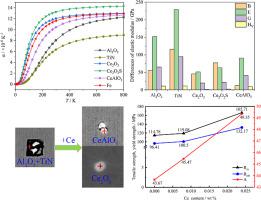当前位置:
X-MOL 学术
›
J. Rare Earths
›
论文详情
Our official English website, www.x-mol.net, welcomes your
feedback! (Note: you will need to create a separate account there.)
Experimental and DFT study on cerium inclusions in clean steels
Journal of Rare Earths ( IF 5.2 ) Pub Date : 2020-07-01 , DOI: 10.1016/j.jre.2020.07.021 Xiangjun Liu , Jichun Yang , Fang Zhang , Xiaoyang Fu , Hongwei Li , Changqiao Yang
Journal of Rare Earths ( IF 5.2 ) Pub Date : 2020-07-01 , DOI: 10.1016/j.jre.2020.07.021 Xiangjun Liu , Jichun Yang , Fang Zhang , Xiaoyang Fu , Hongwei Li , Changqiao Yang

|
Abstract To provide insights for deforming Ce-O-S-Al inclusions in steels and improving the mechanical properties, the evolution process of such harmful inclusions in clean steels was investigated by thermodynamic calculation, metallographic examination, and first-principles calculation in this paper. For the tested IF steel, the thermodynamic analysis results were consistent with the calculated formation enthalpy. After Ce addition, the inclusions were transformed from Al2O3 and TiN-Al2TiO5-Al2O3 to Ce2O3, Ce2O2S, CeAlO3, TiN-Al2TiO5-Ce2O3, and TiN-Al2TiO5-Ce2O2S composite inclusions, which could be confirmed by metallographic examination. The elastic constants were calculated, and the bulk modulus, Young’s modulus, shear modulus and Poisson’s ratio were evaluated by the Voigt-Reuss-Hill (VRH) approximation. All inclusions except Ce2O3 showed apparent brittleness. TiN, Al2O3, Al2TiO5 and CeAlO3 presented much higher hardness than iron matrix, while the hardness of Ce2O3 or Ce2O2S was close to that of iron matrix. The thermal expansion coefficients of Ce2O3 and CeAlO3 were close to that of iron matrix, whereas, Ce2O2S inclusion had largely different thermal expansion coefficient from iron matrix and might deteriorate the steel performance at higher temperatures. The relatively small differences between Ce inclusions and iron matrix in terms of hardness, toughness, brittleness, and thermal expansion coefficient could explain the improvement of the mechanical properties of the tested steel.
中文翻译:

洁净钢中铈夹杂物的实验和 DFT 研究
摘要 为使钢中Ce-OS-Al夹杂物变形,提高力学性能,本文通过热力学计算、金相检验和第一性原理计算研究了清洁钢中此类有害夹杂物的演化过程。对于被测 IF 钢,热力学分析结果与计算的生成焓一致。添加Ce后,夹杂物由Al2O3和TiN-Al2TiO5-Al2O3转变为Ce2O3、Ce2O2S、CeAlO3、TiN-Al2TiO5-Ce2O3和TiN-Al2TiO5-Ce2O2S复合夹杂物,可通过金相检验证实。计算弹性常数,并通过 Voigt-Reuss-Hill (VRH) 近似评估体积模量、杨氏模量、剪切模量和泊松比。除 Ce2O3 外的所有夹杂物均表现出明显的脆性。TiN、Al2O3、Al2TiO5 和CeAlO3 的硬度远高于铁基体,而Ce2O3 或Ce2O2S 的硬度与铁基体接近。Ce2O3 和 CeAlO3 的热膨胀系数接近铁基体的热膨胀系数,而 Ce2O2S 夹杂物的热膨胀系数与铁基体的热膨胀系数大不相同,可能会在较高温度下降低钢的性能。Ce 夹杂物与铁基体在硬度、韧性、脆性和热膨胀系数方面的相对较小的差异可以解释被测钢的机械性能的提高。而Ce2O3或Ce2O2S的硬度接近于铁基体的硬度。Ce2O3 和 CeAlO3 的热膨胀系数接近铁基体的热膨胀系数,而 Ce2O2S 夹杂物的热膨胀系数与铁基体的热膨胀系数大不相同,可能会在较高温度下降低钢的性能。Ce 夹杂物与铁基体在硬度、韧性、脆性和热膨胀系数方面的相对较小的差异可以解释被测钢的机械性能的提高。而Ce2O3或Ce2O2S的硬度接近于铁基体的硬度。Ce2O3 和 CeAlO3 的热膨胀系数接近铁基体的热膨胀系数,而 Ce2O2S 夹杂物的热膨胀系数与铁基体的热膨胀系数大不相同,可能会在较高温度下降低钢的性能。Ce 夹杂物与铁基体在硬度、韧性、脆性和热膨胀系数方面的相对较小的差异可以解释被测钢的机械性能的提高。
更新日期:2020-07-01
中文翻译:

洁净钢中铈夹杂物的实验和 DFT 研究
摘要 为使钢中Ce-OS-Al夹杂物变形,提高力学性能,本文通过热力学计算、金相检验和第一性原理计算研究了清洁钢中此类有害夹杂物的演化过程。对于被测 IF 钢,热力学分析结果与计算的生成焓一致。添加Ce后,夹杂物由Al2O3和TiN-Al2TiO5-Al2O3转变为Ce2O3、Ce2O2S、CeAlO3、TiN-Al2TiO5-Ce2O3和TiN-Al2TiO5-Ce2O2S复合夹杂物,可通过金相检验证实。计算弹性常数,并通过 Voigt-Reuss-Hill (VRH) 近似评估体积模量、杨氏模量、剪切模量和泊松比。除 Ce2O3 外的所有夹杂物均表现出明显的脆性。TiN、Al2O3、Al2TiO5 和CeAlO3 的硬度远高于铁基体,而Ce2O3 或Ce2O2S 的硬度与铁基体接近。Ce2O3 和 CeAlO3 的热膨胀系数接近铁基体的热膨胀系数,而 Ce2O2S 夹杂物的热膨胀系数与铁基体的热膨胀系数大不相同,可能会在较高温度下降低钢的性能。Ce 夹杂物与铁基体在硬度、韧性、脆性和热膨胀系数方面的相对较小的差异可以解释被测钢的机械性能的提高。而Ce2O3或Ce2O2S的硬度接近于铁基体的硬度。Ce2O3 和 CeAlO3 的热膨胀系数接近铁基体的热膨胀系数,而 Ce2O2S 夹杂物的热膨胀系数与铁基体的热膨胀系数大不相同,可能会在较高温度下降低钢的性能。Ce 夹杂物与铁基体在硬度、韧性、脆性和热膨胀系数方面的相对较小的差异可以解释被测钢的机械性能的提高。而Ce2O3或Ce2O2S的硬度接近于铁基体的硬度。Ce2O3 和 CeAlO3 的热膨胀系数接近铁基体的热膨胀系数,而 Ce2O2S 夹杂物的热膨胀系数与铁基体的热膨胀系数大不相同,可能会在较高温度下降低钢的性能。Ce 夹杂物与铁基体在硬度、韧性、脆性和热膨胀系数方面的相对较小的差异可以解释被测钢的机械性能的提高。











































 京公网安备 11010802027423号
京公网安备 11010802027423号